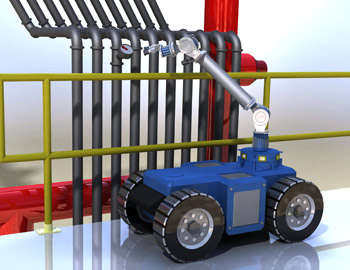 Have you ever walked into a room and wondered “what’s that smell?” At a friend’s house, this might be considered a faux pas but on an oil rig, such an observation could save lives. A new robotic innovation from Carnegie Mellon University may soon save oil rig workers the trouble of sniffing out chemical leaks and dangerous work environments. Say hello to Sensabot.
Have you ever walked into a room and wondered “what’s that smell?” At a friend’s house, this might be considered a faux pas but on an oil rig, such an observation could save lives. A new robotic innovation from Carnegie Mellon University may soon save oil rig workers the trouble of sniffing out chemical leaks and dangerous work environments. Say hello to Sensabot.
Earlier this month, CMU’s National Robotics Engineering Center announced a partnership with North Caspian Operating Company to design, create and demonstrate an oil and gas detecting robot capable of performing routine chemical tests once left up to humans. The result is Sensabot, a rugged rover controlled via wireless network and able to check for leaks, sense changes in air temperature and chemical content, and even climb stairs. Sensabot is being developed for use on the massive Kashagan oil field in Kazakhstan, where NCOC is working on various technologies to reduce human interaction with harmful tasks. CMU engineers hope that Sensabot can cross detection off a long list of dangerous jobs oil workers face everyday.
“Legally, (NCOC) needs to inspect a lot of different equipment on a regular schedule so a person has to go in and do that right now,” says Sensabot project manager Bill Ross. “Obviously hydrogen sulfide gas can be a problem. With all problems you might imagine in an oil and gas facility, there are a lot of benefits if a robot can do that instead.”
As the largest robot engineering facility in the world, CMU is no stranger to building workhorse robots. Engineers have been working on mining robots, nuclear facility inspectors, and other mechanized co-workers that can further reduce human interaction with the dangers of industry. One day, Ross and his colleagues hope to take their bots even further, going beyond sensing problems to actually grabbing a wrench, turning the bolts and fixing the leaks mechanically. The technology is not there yet but Sensabot is a good first step.
“Future robots might have arms, we don’t know,” says Ross. “If it can be useful in the simple sensing task, it would make sense to add new capabilities and see how far it can go.”
Source: Bill Ross, CMU
Writer: John Steele